Ames W.F., Harrel E.M., Herod J.V. (editors). Differential Equations with Applications to Mathematical Physics
Подождите немного. Документ загружается.

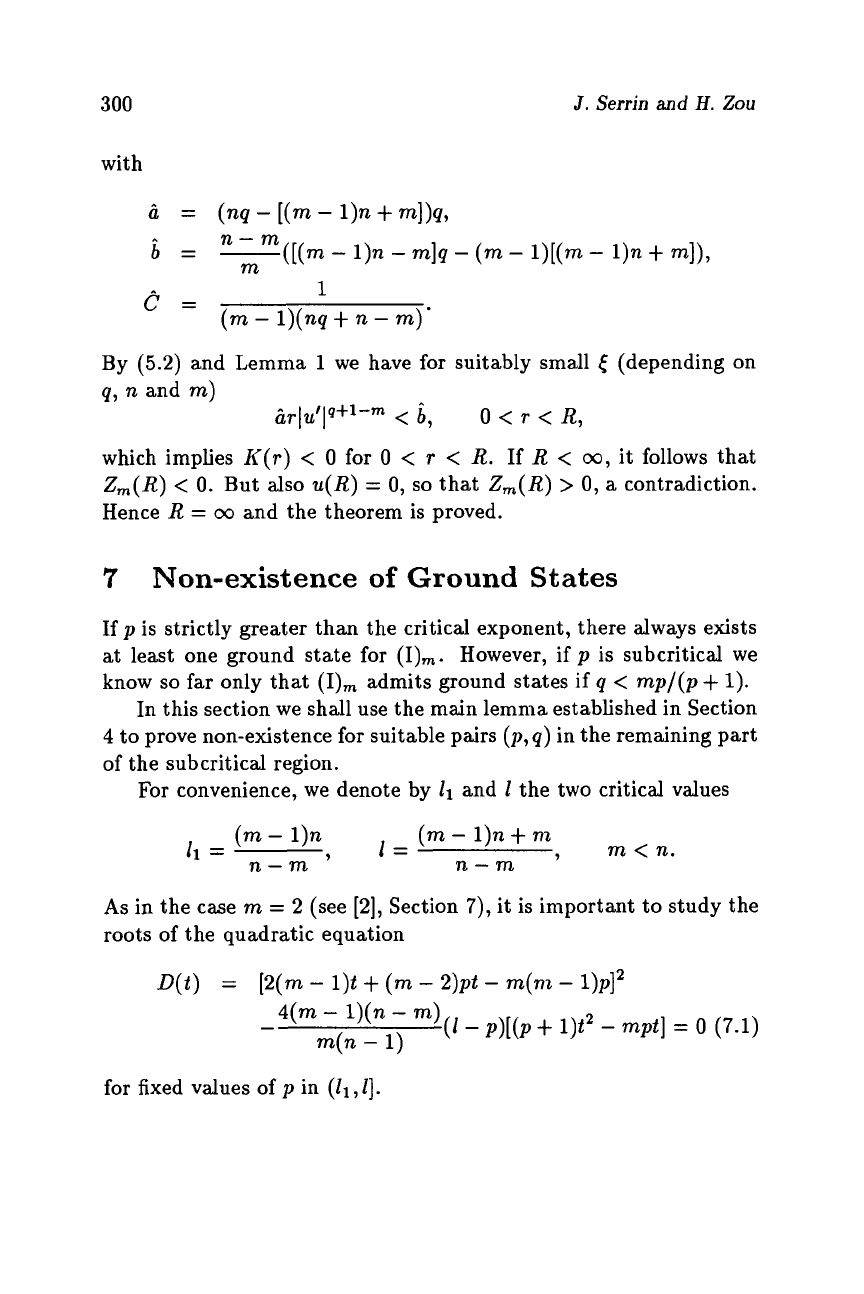
300
J.
Serrin
and
H.
Zou
with
1
c=
(m
-
l)(nq
+
n
-
m)’
By
(5.2)
and Lemma
1
we have for suitably small
<
(depending on
q,
n
and
m)
which implies
K(r)
<
0
for
0
<
r
<
R.
If
R
<
00,
it follows that
Z,(R)
<
0.
But
also
u(R)
=
0,
so
that
Z,(R)
>
0,
a
contradiction.
Hence
R
=
00
and the theorem is proved.
hT
Iu’1
P+l
--m
<&,
o<~<R,
7
Non-existence
of
Ground States
If
p
is strictly greater than the critical exponent, there always exists
at least one ground state for (I)m. However, if
p
is subcritical we
know
so
far only that
(I)m
admits ground states
if
q
<
mp/(p
+
1).
In this section we shall use the main lemma established in Section
4
to prove non-existence for suitable pairs
(p,
q)
in the remaining part
of the subcritical region.
For
convenience, we denote
by
I1
and
1
the two critical values
11
=
,
1=
,
m<n.
(m
-
1).
(m
-
1).
+
nz
n-m
n-m
As
in the case
m
=
2
(see
[2],
Section
7),
it is important to study the
roots of the quadratic equation
D(t)
=
for fixed values
[2(m
-
1)t
+
(m
-
2)pt
-
m(m
-
1)p12
4(m
-
1)(n
-
m)
m(n
-
1)
-
(1
-
p)[(p
+
l)t2
-
mpt]
=
0
(7.1)
of
p
in
(11,1].
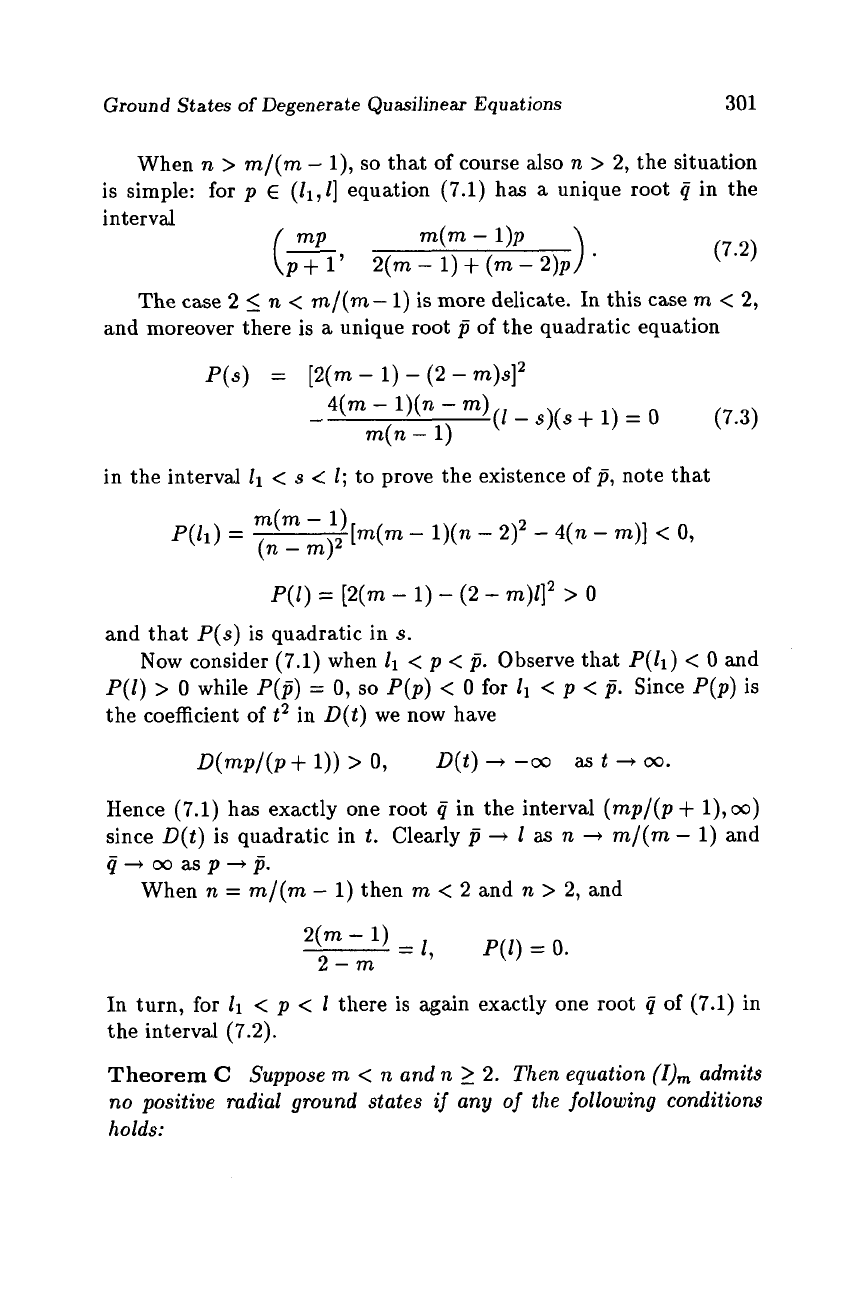
Ground States
of
Degenerate Quasilinear Equations
301
When
n
>
m/(m
-
l),
so
that
of
course also
n
>
2,
the situation
is simple:
for
p
E
(I1,/]
equation (7.1) has
a
unique root
tj
in the
interval
>.
(7.2)
($9
2(m
-
1)
+
(m
-
2)p
m(m
-
1)P
The
case
2
5
TI
<
rn/(m-
1)
is more delicate. In this case
m
<
2,
and moreover there
is
a
unique root
p
of
the quadratic equation
P(s)
=
[2(m
-
1)
-
(2
-
m)sI2
4(m
-
1)(n
-
m)
-
(I
-
s)(s
t
1)
=
0
(7.3)
m(n
-
1)
in the interval
I1
<
s
<
1;
to prove the existence
of
p,
note that
P(1)
=
[2(m
-
1)
-
(2
-
m)ZI2
>
0
and that
P(s)
is quadratic in
s.
Now consider (7.1) when
11
<
p
<
p.
Observe that
P(I1)
<
0
and
P(I)
>
0
while
P(p)
=
0,
so
P(p)
<
0
for
I1
<
p
<
p.
Since
P(p)
is
the coefficient
of
t2
in
D(t)
we now have
D(mp/(p+
1))
>
0,
D(t)
+
-00
as
t
+
00.
Hence (7.1) has exactly one root
tj
in the interval
(mp/(p
t
l),~)
since
D(t)
is
quadratic in
t.
Clearly
p
+
I
as
n
+
m/(m
-
1)
and
q+masp--+p.
When
n
=
m/(m
-
1)
then
m
<
2
and
n
>
2, and
2(m
-
1)
2-m
=
I,
P(I)
=
0.
In turn,
for
11
<
p
<
I
there
is
again exactly one root
tj
of
(7.1) in
the interval (7.2).
Theorem
C
Suppose
m
<
n
and
n
2
2.
Then equation
(I),,,
admits
no
positive
radial ground states
if
any
of
the following conditions
holds:
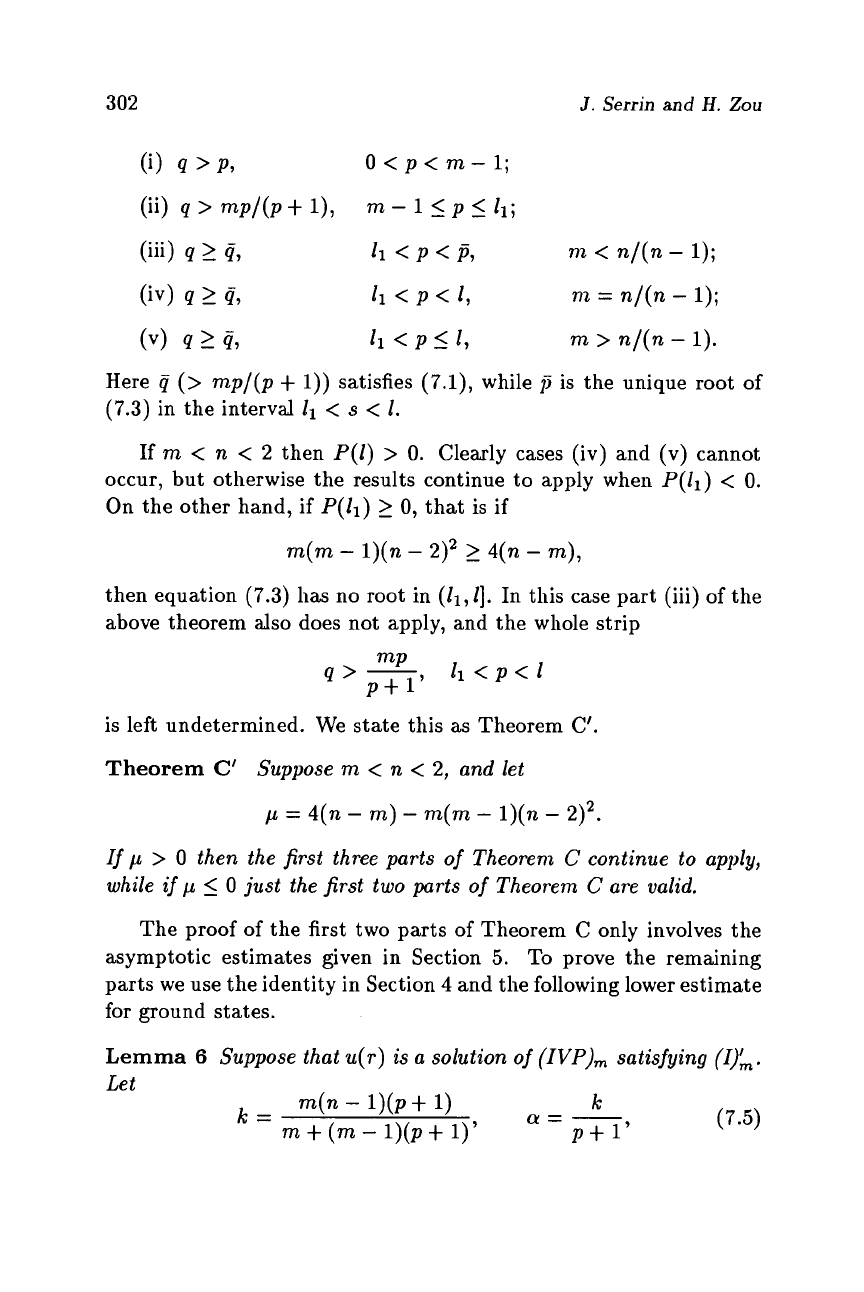
302
J.
Serrin
and
H.
Zou
(4
9
>
mP/(P
+
11,
m
-
1
L
P
L
11;
11
<
P
<
p,
11
<
P
<
1,
11
<
P
I
1,
(iii)
9
2
Q,
(iv)
9
2
Q,
(4
9
2
q,
nz
<
n/(n
-
1);
nz
=
n/(n
-
1);
m
>
n/(n
-
1).
Here
Q
(>
mp/(p
+
1))
satisfies
(7.1),
while
p
is the unique root of
(7.3)
in the interval
11
<
s
<
1.
If
m
<
n
<
2
then
P(1)
>
0.
Clearly cases
(iv)
and
(v)
cannot
occur, but otherwise the results continue to apply when
P(11)
<
0.
On the other hand, if
P(l1)
2
0,
that is if
m(m
-
1)(n
-
2)2
2
4(n
-
m),
then equation
(7.3)
has no root in
(II,~].
In this case part (iii) of the
above theorem
also
does not apply, and the whole strip
9>-
mp
11<p<l
p+
1’
is left undetermined. We state this as Theorem
C’.
Theorem
C’
Suppose
m
<
n
<
2,
and let
p
=
4(n
-
m)
-
m(m
-
I>(.
-
212.
If
p
>
0
then the first three parts
of
Theorem
C
continue to apply,
while
if
p
5
0
just the first two parts
of
Theorem
C
are valid.
The proof of the first two parts
of
Theorem
C
only involves the
asymptotic estimates given in Section
5.
To
prove the remaining
parts we use the identity in Section
4
and the following lower estimate
for ground states.
Lemma
6
Suppose that u(r) is
a
solution
of
(IVP),
satisfying
(I,,,.
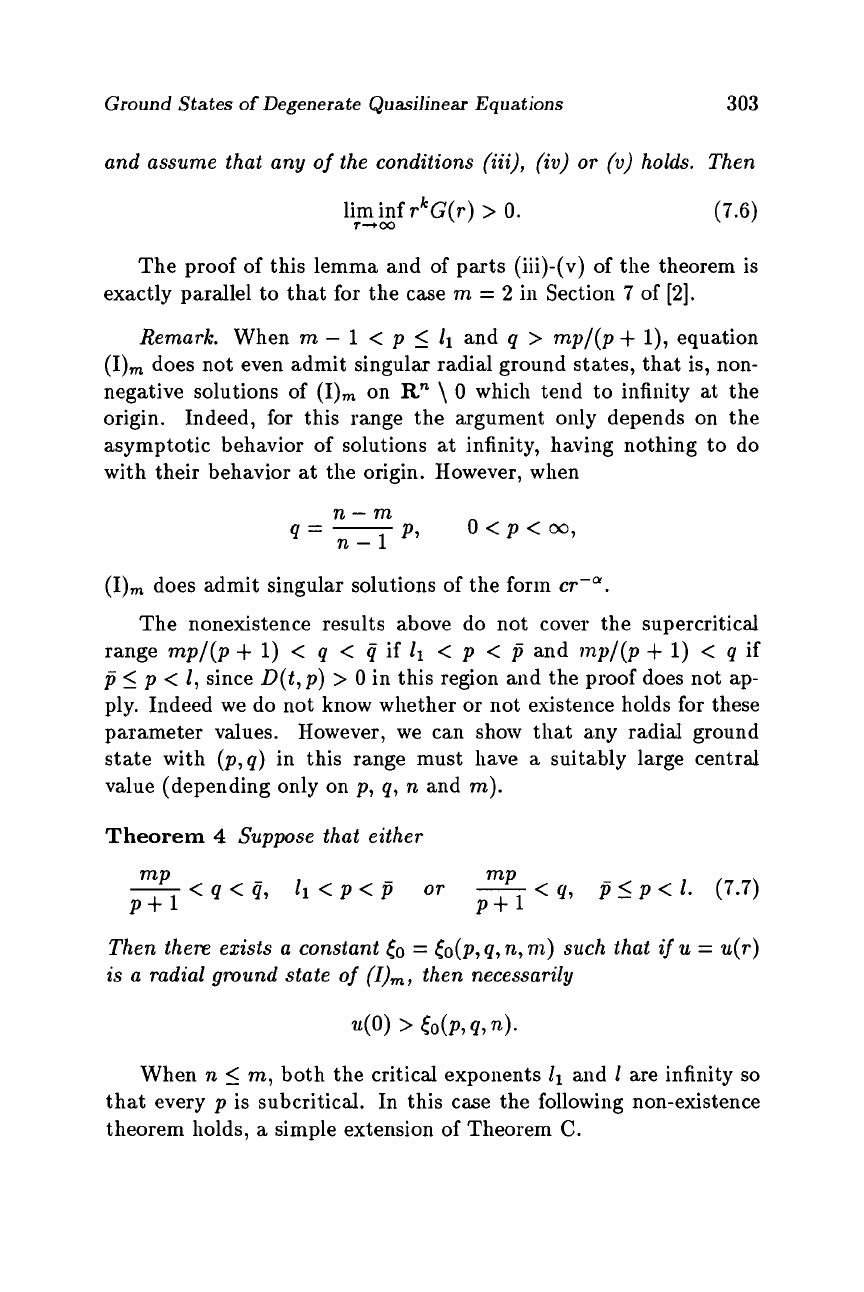
Ground States
of
Degenerate Quasilinear Equations
303
and assume that any
of
the conditions (iii),
(iv)
or
(v)
holds. Then
liminf
T+oO
rkG(r)
>
0.
(7.6)
The proof of this lemma and of parts (iii)-(v) of the theorem is
exactly parallel to that for the case
m
=
2
in Section
7
of
[2].
Remark.
When
m
-
1
<
p
5
11
and
q
>
mp/(p
+
l),
equation
(I)m
does not even admit singular radial ground states, that is, non-
negative solutions
of
(1)m
on
R"
\
0
which tend to infinity at the
origin. Indeed,
for
this range the argument only depends on the
asymptotic behavior of solutions at infinity, having nothing to do
with their behavior at the origin. However, when
n-m
n-1
q=-
P,
o<p<m,
(I)m
does admit singular solutions of the form
cr-a.
The nonexistence results above do not cover the supercritical
range
mp/(p
+
1)
<
q
<
a
if
11
<
p
<
jj
and
mp/(p
+
1)
<
q
if
jj
5
p
<
1,
since
D(t,p)
>
0
in this region and the proof does not ap-
ply. Indeed we do not know whether
or
not existence holds for these
parameter values. However, we can show that any radial ground
state with
(p,q)
in this range must have
a
suitably large central
value (depending only on
p,
q,
n
and
m).
Theorem
4
Suppose
that either
mp
<q<q,
11<p<p
Of
-
mp
<
q,
p
5
p
<
1.
(7.7)
P+l P+l
Then there exists
a
constant
(0
=
<o(p,q,n,m)
such
that
if
u
=
u(r)
is a radial
ground
state
of
(I)m,
then necessarily
When
n
5
m,
both the critical exponents
I1
and
l
are infinity
so
that every
p
is subcritical. In this case the following non-existence
theorem holds,
a
simple extension of Theorem
C.
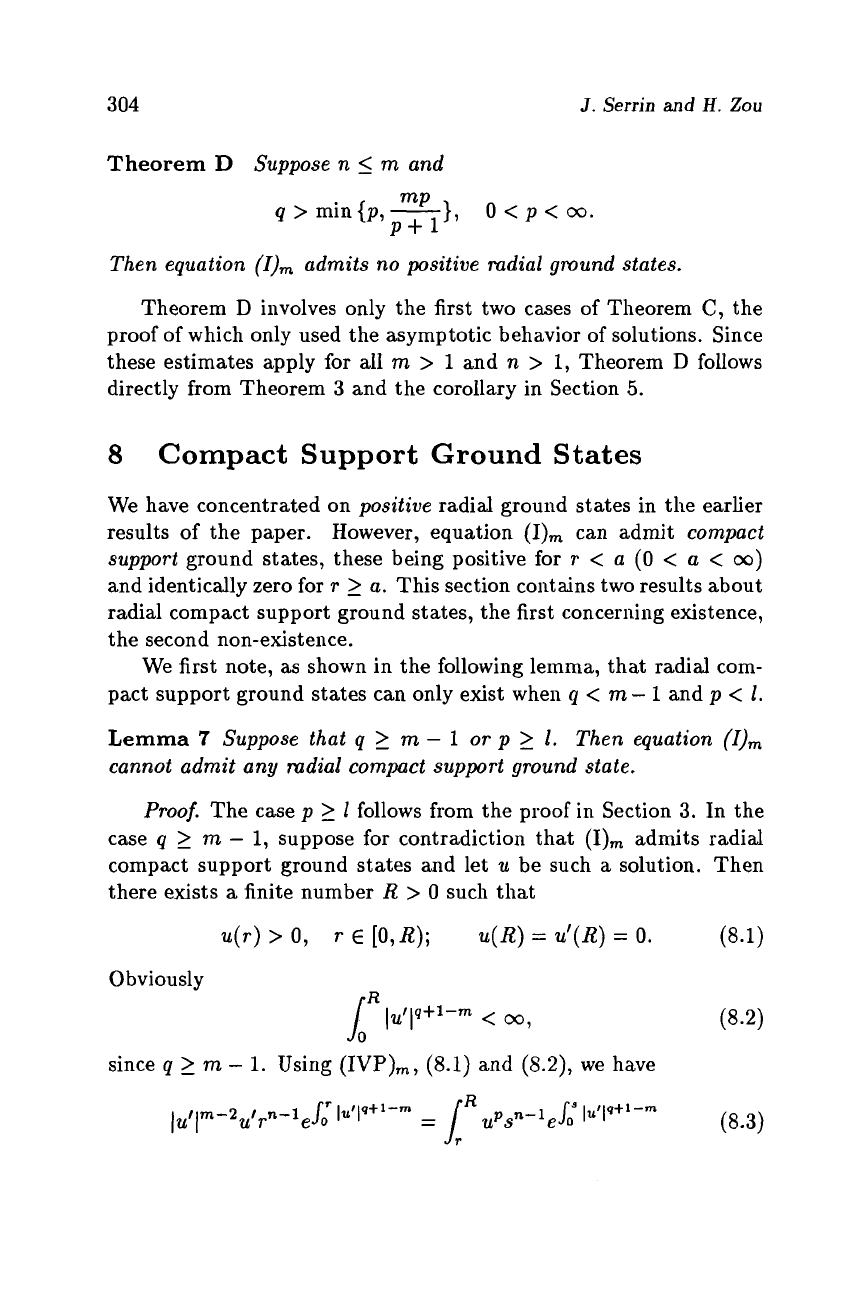
304
J.
Serrin
and
H.
Zou
Theorem
D
Suppose
n
5
m
and
Then equation
(I)m
admits no positive radial ground states.
Theorem
D
involves only the first two cases
of
Theorem
C,
the
proof of which only used the asymptotic behavior of solutions. Since
these estimates apply
for
all
m
>
1
and
n
>
1,
Theorem
D
follows
directly from Theorem
3
and the corollary in Section
5.
8
Compact Support Ground
States
We have concentrated on
positive
radial ground states in the earlier
results of the paper. However, equation
(I)m
can admit
compact
support
ground states, these being positive for
r
<
a
(0
<
a
<
w)
and identically zero for
r
2
a.
This section contains two results about
radial compact support ground states, the first concerning existence,
the second non-existence.
We first note,
as
shown in the following lemma, that radial com-
pact support ground states can only exist when
q
<
m-
1
and
p
<
1.
Lemma
7
Suppose that q
2
m
-
1
or
p
2
1.
Then equation
(I)m
cannot admit any mdid compact support ground state.
Proof.
The case
p
2
I
follows from the proof in Section
3.
In the
case
q
2
m
-
1,
suppose for contradiction that
(1)m
admits radial
compact support ground states and let
u
be such
a
solution. Then
there exists
a
finite number
R
>
0
such that
0
bviously
since
q
2
m
-
1.
Using
(IVP),,
(8.1)
and
(8.2),
we have
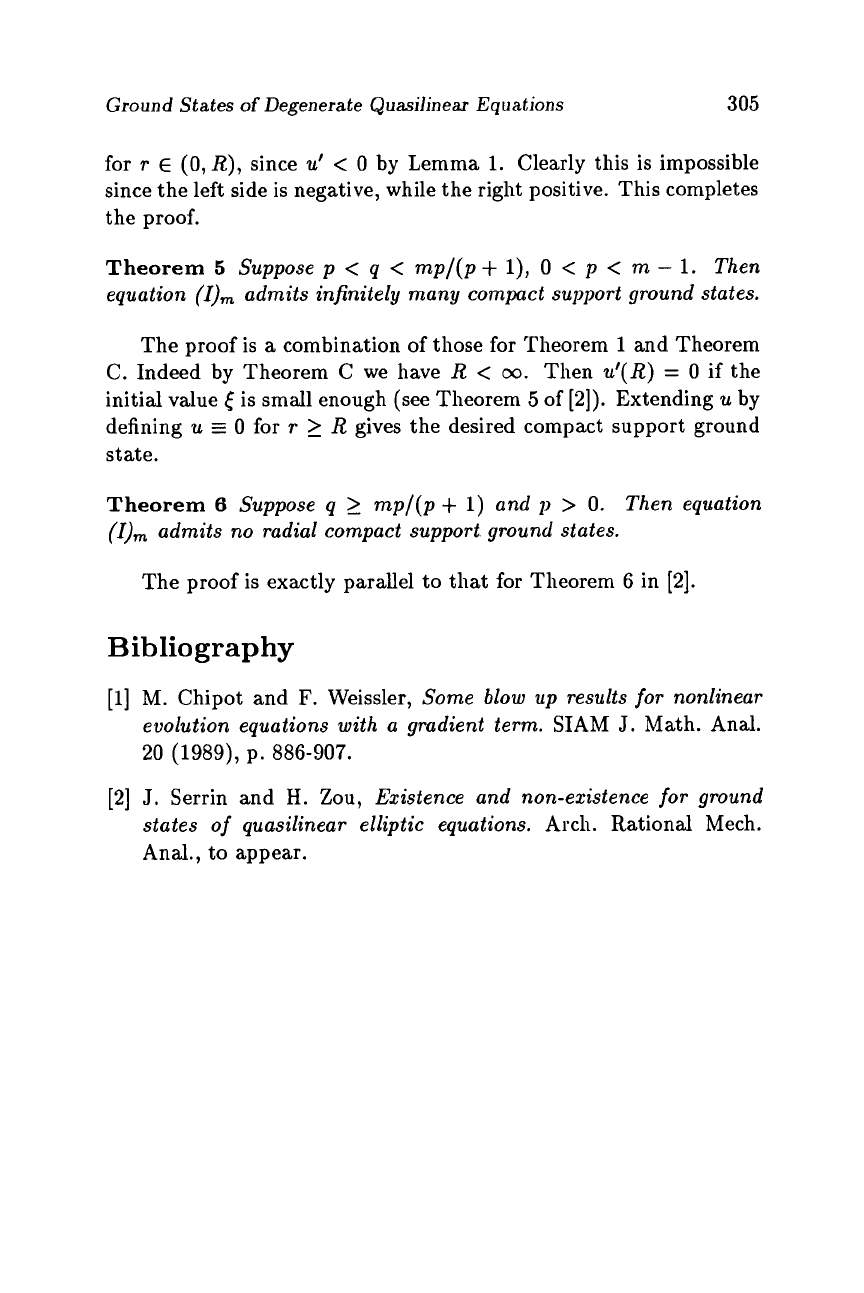
Ground States
of
Degenerate Quasilinear Equations
305
for
r
E
(O,R),
since
u'
<
0
by Lemma
1.
Clearly this is impossible
since the left side is negative, while the right positive. This completes
the proof.
Theorem
5
Suppose p
<
q
<
mp/(p
+
l),
0
<
p
<
m
-
1.
Then
equation
(I)m
admits infinitely many compact support ground states.
The proof
is
a
combination of those for Theorem
1
and Theorem
C. Indeed by Theorem C we have
R
<
00.
Then u'(R)
=
0
if the
initial value
(
is small enough (see Theorem
5
of
[2]).
Extending
u
by
defining
u
=
0
for
T
2 R
gives the desired compact support ground
state.
Theorem
6
Suppose q
2
mp/(p
+
1)
and
p
>
0.
(I)m
admits
no
radial compact support ground states.
Then equation
The proof is exactly parallel to that
for
Theorem
6
in
[2].
Bibliography
[l]
M. Chipot and
F.
Weissler,
Some blow up results for nonlinear
evolution equations with a gradient term.
SIAM
J.
Math. Anal.
20
(1989), p. 886-907.
[2]
J.
Serrin and
H.
Zou,
Existence and non-existence for ground
states
of
quasilinear elliptic equations.
Arch. Rational Mech.
Anal., to appear.
This page intentionally left blank
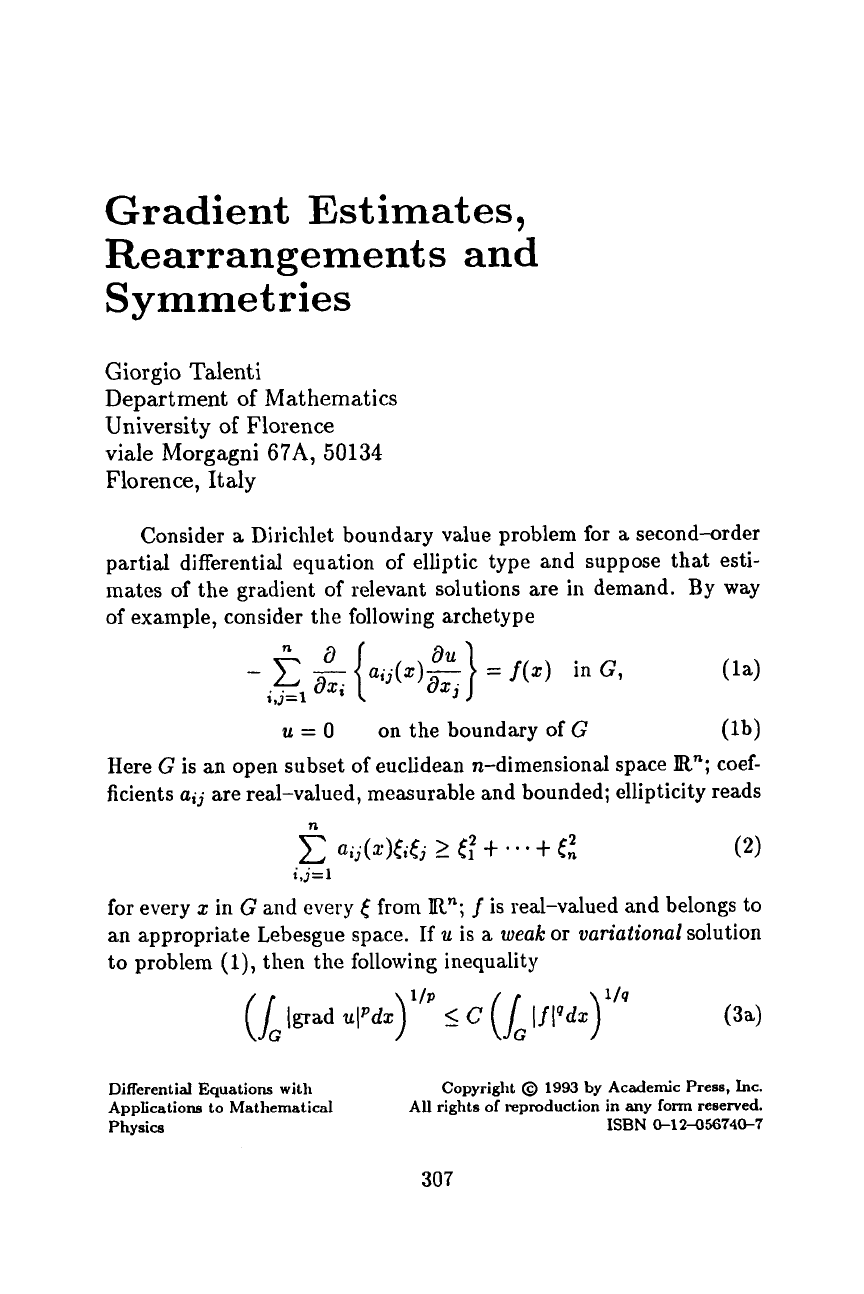
Gradient Estimates,
Rearrangements
and
Symmetries
Giorgio Talenti
Department
of
Mathematics
University
of
Florence
viale Morgagni
67A,
50134
Florence, Italy
Consider
a
Dirichlet boundary value problem for
a
second-order
partial differential equation
of
elliptic type and suppose that esti-
mates
of
the gradient
of
relevant solutions are in demand.
By
way
of
example, consider the following archetype
u
=
0
on the boundary of
G
(W
Here
G
is an open subset of euclidean n-dimensional space
Rn;
coef-
ficients
aij
are real-valued, measurable and bounded; ellipticity reads
n
C
aij(z)titj
2
t;
t
* *
*
t
ti
(2)
i,j=l
for
every
x
in
G
and cvery
t
from
Rn;
f
is real-valued and belongs to
an appropriate Lebesgue space.
If
u
is
a
weak
or
variational
solution
to problem
(l),
then the following inequality
Differential Equations
with
Copyright
@
1993
by
Academic Press, Inc.
Applications to Mathematical
All
rights
of
reproduction
in
any
form
reserved.
Physics
ISBN
0-12-056740-7
307

308
Giorgio
Talen
ti
holds, where
q
=
np/(n
+p)
and
n/(n
-
1)
5
p
5
2.
The inequality is
sharp:
some
coefficients
a;j,
some domain
G,
and special
f
and
u
exist which
render
(3a)
an equality. Inequality (3) is an easy corollary of the
following theorem.
Theorem
1
Consider the variational problem:
lgrad
ulpdx
=
maximum,
Jl
where u is
a
weak
solution to problem
(l),
and domain
G,
coefficients
a;j, and right-hand side
f
are the competing variables. Assume the
measure
of
G
is given; coefficients a;j satisfy ellipticity condition
(2);
f
belongs to
L2n/(n+2)(G)
and is equidistributed with
a
given
function.
In other words, the collection
of
those points x from
G
such that
If
(.)I
exceeds t
-
a
level set
of
f
-
has
a
prescribed
measure for every nonnegative t. (There are some minor alterations
if
the dimension,
n,
is
2.)
Assume
0
<
p
5
2.
Then the maximum
in
question is acheived when
G
is
a
ball
-
centered at the origin,
say;
a;j
=
6;j,
the coefficients
of
Laplace operator;
f
is nonnegative,
spherically symmetric
-
i.e., invariant under rotations about the
origin
-
and radially decreasing.
Inequality (3) and Theorem
1
appeared in
[GI.
Related results
and
a
bibliography are presented in
[7].
Further advances are in
[l].
Now let
a
nonnegative nonincreasing function
p
be given, assume
f
obeys
for every nonnegative
t
and belongs to appropria.te Lebesgue spaces,
and consider the following problem
measure
of
{x
E
R"
:
I
f(x)1
>
t}
=
p(t)
(4)
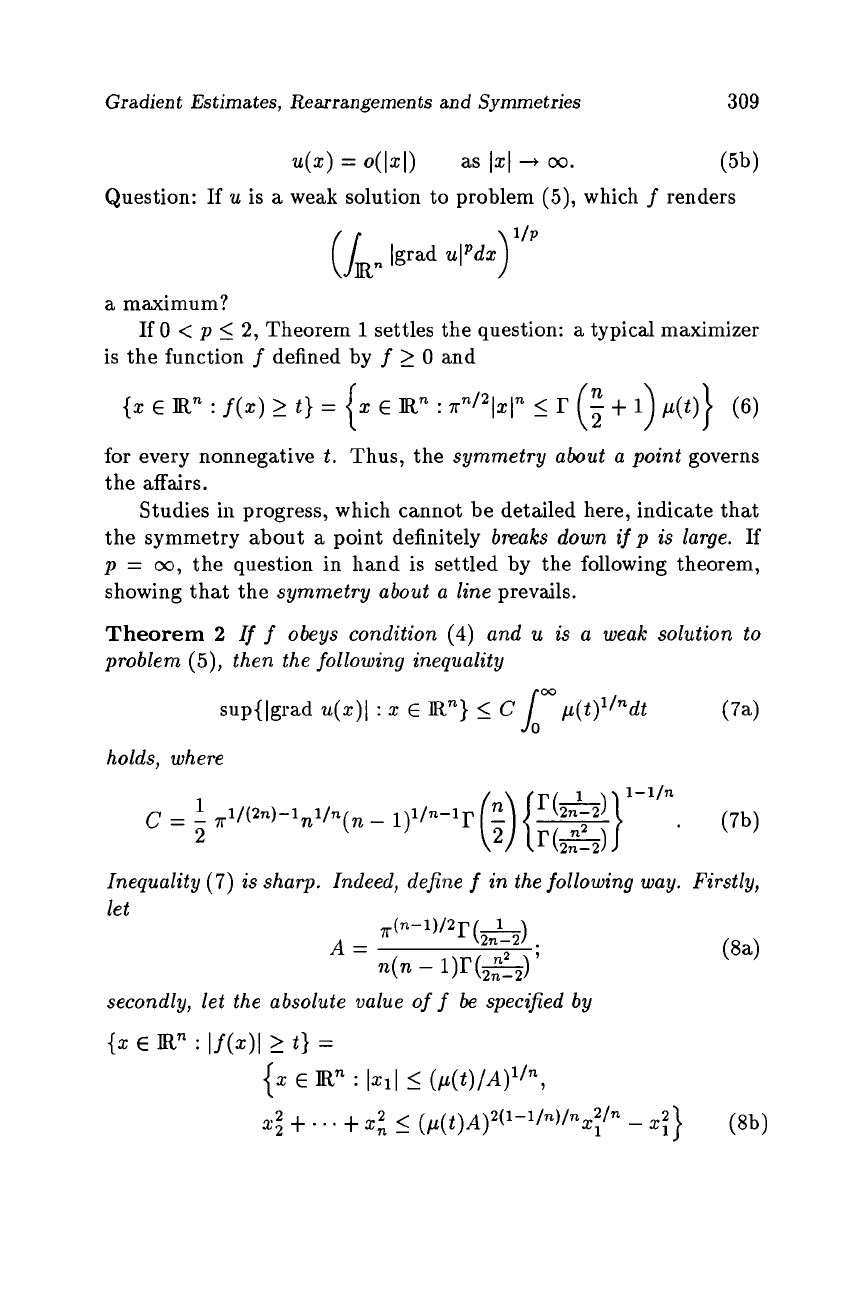
Gradient Estimates, Rearrangements and Symmetries
309
U(X)
=
o(IzI)
as
1x1
--f
00.
(5b)
Question: If
u
is
a
weak solution to problem (5)' which
f
renders
a
maximum?
is the function
f
defined by
f
2
0
and
If
0
<
p
5
2,
Theorem
1
settles the question:
a
typical maximizer
{X
E
R"
:
f(X)
2
t}
=
x
E
R"
:
T~/~~x)~
5
r
-
+
1
p(t)
(6)
for
every nonnegative
t.
Thus, the
symmetry about a point
governs
the affairs.
Studies in progress, which cannot be detailed here, indicate that
the symmetry about
a
point definitely
breaks down ifp
is
large.
If
p
=
00,
the question in hand is settled by the following theorem,
showing that the
symmetry about a line
prevails.
Theorem
2
Iff obeys condition
(4)
and
u
is a weak solution
to
problem
(5),
then the following inequality
{
(:
)
I
holds, where
Inequality
(7)
is sharp. Indeed, define
f
in
the following way. Firstly,
let
secondly, let the absolute value
off
be
specified
by
{X
E
IR"
:
If(.)/
2
t}
=
{.
E
IRn
:
14
5
(P(t)/A)'/"'
2;
+
.
.
+
z2
n-
<
(p(t)A)2(1-'/")/"r:/n
-
x:}
(8b)
